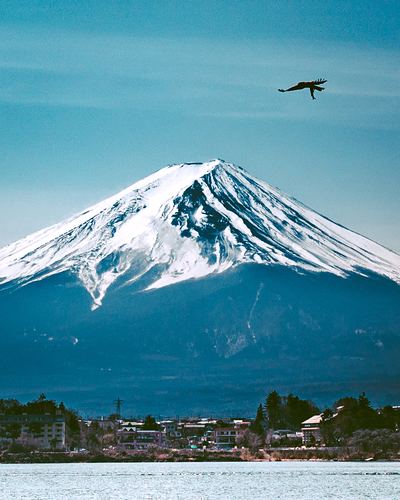Visitando Mount Fuji
Interesante información sobre el complejo para ayudarte a planificar tu viaje a Mount Fuji
- Inicio de Temporada—
- Fin de Temporada—
- Alojamiento—
- Restaurantes | Bares— | —
- Aeropuerto Más Cercano Tokyo
- Estación de Tren Más Cercana —
- Página web de la Oficina de Turismo
- Tel. Oficina de Turismo—
Características de Mount Fuji
La zona de Mount Fuji incluye::
- Medio caño—
- Terrenos de Parques—
- Esquí de travesía—
- Alquiler de esquí—
What's it like at Mount Fuji?
Fuji-san or Mount Fuji is the highest mountain in Japan at 12,389 feet (3,776 metres). It is an isolated volcano, located only 50 miles southwest from Tokyo, which contributes to its popularity. Thousands of climbers, tourists, and religious pilgrims ascend to the summit of Mount Fuji each year. The mountain has traditionally been sacred to the Shinto religion, and has remained sacred to Buddhists as Buddhism has become Japan's predominant religion. Three temples (plus a weather observatory) have been erected on the summit. No record exists of the first ascent of Fuji-san, but oral tradition states that a Buddhist monk first climbed the mountain in the seventh century. The mountain is now dormant, but it has erupted eighteen times in recorded history, and many more times according to geological evidence. The last eruption of Mount Fuji occurred in 1708. Perhaps, ironically for a sacred mountain, the foothills have been developed as a summer and winter sports area, and skiing on the mountain is popular in the winter. The majority of people who climb the mountain, however, do so with respect for its sanctity, and quiet meditation is common on its summit. The official climbing season for Fuji-san or Mount Fuji is July and August, but many climb in surrounding months to avoid the crowds.
Fotos más recientes de Mount Fuji Ver todas las fotos en la página de la galería de Mount Fuji
 Crédito de la foto: Snow Forecast Admin
Crédito de la foto: Snow Forecast Admin Crédito de la foto: Snow Forecast Admin
Crédito de la foto: Snow Forecast Admin Crédito de la foto: gp420
Crédito de la foto: gp420
Explore el mapa de Mount Fuji
Mapa interactivo de los senderos y las pistas de Mount Fuji. Examine la pista y los senderos, así como el terreno circundante y los contornos de las montañas, para ver qué actividades de campo a través puede hacer.

Tiempo actual en Mount Fuji
| Estación | Profundidad de Nieve | Temp. (°F) | Viento (mph) | Tiempo | ||
|---|---|---|---|---|---|---|
| Remonte de arriba: | 16 | |||||
| Remonte de la mitad: | 23 | |||||
| Remonte de abajo: | 28 | |||||
¿Cuál es el mes con más nieve para visitar Mount Fuji?
¿Qué aspecto tiene la nieve ahora en Mount Fuji??
Resumen del estado actual de la nieve en Mount Fuji. Consulta más información en Mount Fuji Página del parte de nieve detallado.
- Estado de las pistas—
- Estado fuera de las pistas—
| Profundidad de Nieve Arriba: | ||
|---|---|---|
| Profundidad de Nieve abajo: | ||
Comentarios de Visitantes para Mount Fuji
Jasbir de Japan escribe:
Since discovering this site, I always check the weather forecast on the summit before going to Mt. Fuji.
I have been to the summit 25 times now. The forecast, on this site, is generally very accurate but the weather on Fuji is changeable and on my last trip (August 15) the forecast was for a clear night sky, mild temperatures and all good for a sunrise. Things took a turn around 01:00 around 3200m with heavy rain and very strong winds. The rain stopped around 05:00 but the winds remained moderately strong until at least 07:00 by which time I was heading back down from the summit.
Most important thing is to be prepared just in case there is a change in the weather. Some extra layers and waterproofs, even when the forecast is good, are definitely a must.
Mt. Fuji is great. I have this site bookmarked and I'm often checking the forecast a week ahead if I get that feeling I need to go to again.
Safe climbing !
Lea 6 otras críticas de Mount Fuji o entrega su propio comentario
Complejos próximos a Mount Fuji
Descubre complejos de esquí próximos a Mount Fuji. Haz clic abajo para ver guías de complejos de esquí en la zona.
 Fujiten Snow ResortÚltima nieve: 3.1 in Mon 31 Mar
Fujiten Snow ResortÚltima nieve: 3.1 in Mon 31 MarRemontes: 4
Pistas: 5
5.6 miles de distancia Snow Town YetiÚltima nieve: 2.4 in Mon 31 Mar
Snow Town YetiÚltima nieve: 2.4 in Mon 31 MarRemontes: 3
Pistas: 4
5.6 miles de distancia Kamui MisakaÚltima nieve: 2.8 in Mon 31 Mar
Kamui MisakaÚltima nieve: 2.8 in Mon 31 MarRemontes: 5
Pistas: 5
14.9 miles de distancia Shizuokashi Riverwell IkawaÚltima nieve: 2.0 in Mon 31 Mar
Shizuokashi Riverwell IkawaÚltima nieve: 2.0 in Mon 31 MarRemontes: 1
Pistas: 2
26.7 miles de distancia